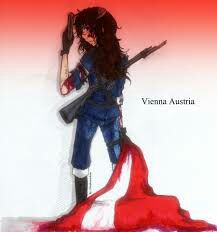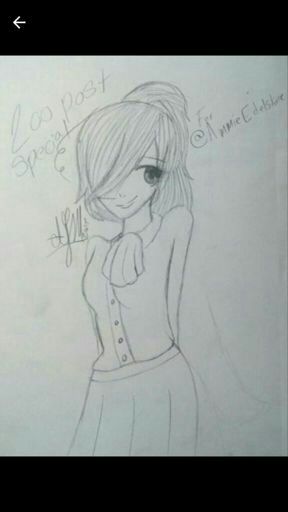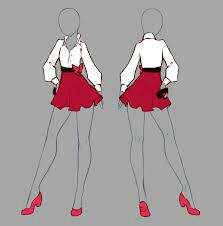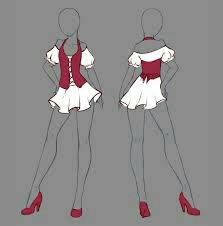Vienna
Capital Name- Vienna
Name- America Eadlyn Edelstein
Year Age-214
Age-20
Looks-



Quote- "Ich habe mein Land für mien big Bruders Leben gerettet!"
(Translates- I saved my country for my big brother's life)
Wears-


Backstory-The history of Vienna has been long and varied, beginning when the Roman Empirecreated a military camp in the area covered by Vienna's city centre. From that humble beginning, Vienna grew from the Roman settlement known as Vindobona to be an important trading site in the 11th century. It became the capital of the Babenberg dynasty and subsequently of the Austrian Habsburgs, under whom it became one of Europe'scultural hubs. During the 19th century as the capital of the Austrian Empire and later Austria-Hungary, it temporarily became one of Europe's biggest cities. Since World War I, Vienna has been the capital of the Republic of Austria.
The name Vindobona derives from a Celtic language, suggesting that the region must have been inhabited before Roman times. The Romans created a military camp (occupied by Legio X Gemina) during the 1st century on the site of the city centre of present-day Vienna. The settlement was raised to the status of a municipium in 212. Even today, the streets of the First District show where the encampment placed its walls and moats. The Romans stayed until the 5th century.
Roman Vindobona was located in the outskirts of the empire and thus fell prey to the chaos of the Völkerwanderung. There are some indications that a catastrophic fireoccurred around the beginning of the 5th century. However, the remains of the encampment were not deserted, and a small settlement remained. The streets and houses of early medieval Vienna followed the former Roman walls, which gives rise to the conclusion that parts of the fortification were still in place and used by the settlers.
Byzantine copper coins from the 6th century have been found several times in the area of today's city centre, indicating considerable trade activity. Graves from the 6th century were found during excavations next to the Berghof, in an area around Salvatorgasse. At that time, the Lombards controlled the area, with Slavs and Avars following later. Early Vienna was centred on the Berghof. One of the earliest references to Vienna is from the Jewish historian, Josephus, who recounts that the king of Judea, Herod Archelaus (ca. 23 BCE – 18 CE) was banished to the city of Vienna in Gaul by Caesar.[1]
The first documented mention of the city during the Middle Ages is within the Salzburg Annals, dating to 881, when a battle apud Weniam was fought against the Magyars. However, it is unclear whether this refers to the city or the River Wien. Emperor Otto Idefeated the Magyars in 955 in the Battle of Lechfeld. This allowed early Vienna to start to develop towards the Middle Ages
In 976, the Margraviate of Ostarrîchi was given to the Babenberg family. Vienna lay at its border to Hungary.
Vienna was an important site of trade as early as the 11th century. In the Exchange of Mautern between the Bishop of Passau and Margrave Leopold IV, Vienna is mentioned as a Civitas for the first time, which indicates the existence of a well-ordered settlement. In 1155, Duke Henry II of Austria made Vienna his capital. In 1156, Austria was raised to a duchy in the Privilegium Minus, with Vienna becoming the seat of the duke. During that time, the Schottenstift was founded.
The events surrounding the Third Crusade, during which King Richard the Lionheart was discovered and captured by Duke Leopold V the Virtuous two days before Christmas of 1192 in Erdberg near Vienna, brought an enormous ransom of 50,000 Silver Marks (about 10 to 12 tons of silver, about a third of the emperor's claims against the English. Richard had been extradited to him in March 1193). This allowed the creation of a mint and the construction of city walls around the year 1200. At the U-Bahn station Stubentor, some remains of the city walls can still be seen today. Because he had abused a protected crusader, Leopold V was excommunicated by Pope Celestine III, and died (without having been absolved) after falling from a horse in a tournament.
In 1221, Vienna received the rights of a cityand as a staple port (Stapelrecht). This meant that all traders passing through Vienna had to offer their goods in the city. This allowed the Viennese to act as middlemen in trade, so that Vienna soon created a network of far-reaching trade relations, particularly along the Danubebasin and to Venice, and to become one of the most important cities in the Holy Roman Empire.
However, it was considered embarrassing that Vienna did not have its own bishop. It is known that Duke Frederick II negotiated about the creation of a bishopric in Vienna, and the same is suspected of Ottokar Přemysl
In 1278, Rudolf I took control over the Austrian lands after his victory over Ottokar II of Bohemia and began to establish Habsburgrule. In Vienna, it took a relatively long time for the Habsburgs to establish their control, because partisans of Ottokar remained strong for a long time. There were several uprisings against Albert I. The family of the Paltrams vom Stephansfreithof was foremost among the insurgents.
In 1280, Jans der Enikel wrote the "Fürstenbuch", a first history of the city.
With the Luxembourg emperors, Praguebecame the imperial residence and Vienna stood in its shadow. The early Habsburgs attempted to extend it in order to keep up. Duke Albert II, for example, had the gothicchoir of the Stephansdom built. In 1327, Frederick the Handsome published his edict allowing the city to maintain an Eisenbuch(iron book) listing its privileges.
Rudolf IV of Austria deserves credit for his prudent economic policy, which raised the level of prosperity. His epithet the Founder is due to two things: first, he founded the University of Vienna in 1365, and second, he began the construction of the gothic nave in the Stephansdom. The latter is connected to the creation of a metropolitan chapter, as a symbolic substitute for a bishop.
There was a period of inheritance disputes among the Habsburgs resulting not only in confusion, but also in an economic decline and social unrest, with disputes between the parties of patricians and artisans. While the patricians supported Ernest the Iron, the artisans supported Leopold IV. In 1408, the mayor Konrad Vorlauf, an exponent of the patrician party, was executed.
After the election of Duke Albert V as German King Albert II, Vienna became the capital of the Holy Roman Empire. Albert's name is remembered for his expulsion of the Jewishpopulation of Vienna in 1421/22.
Eventually, in 1469, Vienna was given its own bishop, and the Stephansdom became a cathedral. During the upheavals of the era of the weak Emperor Frederick III, Vienna remained on the side of his opponents (first Albert VI, then Matthias Corvinus), as Frederick proved unable to maintain peace in the land vis-à-vis rampaging gangs of mercenaries (often remaining from the Hussite Wars).
In 1522, under Ferdinand I, Holy Roman Emperor the Blood Judgment of Wiener Neustadt led to the execution of leading members of the opposition within the city, and thus a destruction of the political structures. From then on, the city stood under direct imperial control.
In 1556, Vienna became the seat of the Emperor, with Hungary and Bohemia having been added to the Habsburg realm in 1526.
During this time, the city was also recatholicised after having become Protestantrather quickly. In 1551, the Jesuits were brought to town and soon gained a large influence in court. The leader of the counterreformation here was Melchior Khlesl, Bishop of Vienna from 1600.
In 1529, Vienna was besieged by the Ottoman Turks for the first time (the First Turkish Siege), although unsuccessfully. The city, protected by medieval walls, only barely withstood the attacks, until epidemics and an early winter forced the Turks to retreat. The siege had shown that new fortifications were needed. Following plans by Sebastian Schrantz, Vienna was expanded to a fortressin 1548. The city was furnished with eleven bastions and surrounded by a moat. A glaciswas created around Vienna, a broad strip without any buildings, which allowed defenders to fire freely. These fortifications, which accounted for the major part of building activities well into the 17th century, became decisive in the Second Turkish Siege of 1683, as they allowed the city to maintain itself for two months, until the Turkish army was defeated by the army led by the Polish King Jan Sobieski. This was the turning point in the Turkish Wars, as the Ottoman Empire was pushed back more and more during the following decades.
The following period was characterised by extensive building activities. In the course of reconstruction, Vienna was largely turned into a baroque city. The most important architectswere Johann Bernhard Fischer von Erlach and Johann Lukas von Hildebrandt. Most construction happened in the suburbs (Vorstädte), as the nobility began to cover the surrounding land with garden palaces, known as Palais. The best known are the Palais Liechtenstein, Palais Modena, Schönbrunn Palace, Palais Schwarzenberg, and the Belvedere (the garden palais of Prince Eugene of Savoy). In 1704, an outer fortification, the Linienwall, was built around the Vorstädte.
After the extensive plague epidemics of 1679 and 1713, the population began to grow steadily. It is estimated that 150,000 people lived in Vienna in 1724, and 200,000 in 1790. At that time, the first factories were built, starting in Leopoldstadt. Leopoldstadt also became a site where many Jews lived, as they had been driven out of their 50-year-old ghettoin 1670. Hygienic problems began to become noticeable: sewers and street cleaning began to develop. Also in this time, the first house numbers (the Konskriptionsnummern) were issued, and the government postal system began to develop.
Under Emperor Joseph II, the city administration was modernized in 1783: officials in charge of only the city were introduced, and the Magistrate was created. At the same time, the graveyards within the city were closed
During the Napoleonic Wars, Vienna was taken by Napoleon twice, in 1805 and 1809. The first conquest happened without a battle. Three French marshals crossed the strongly defended Taborbrücke (Tábor Bridge), the only Danube bridge at that time, and convinced the Austrian commander that the war was already over. In the meantime, the French army easily entered the city and was greeted by the population with interest rather than rejection. Napoleon allowed 10,000 men of the Vienna national guard to remain armed and left the arsenal to them when he left, as complete as he had found it.
However, the second occupation happened only after heavy fire. Shortly after, Napoleon suffered his first large defeat at Aspern, nearby. Less than two months later, his army crossed the Danube again and fought the Battle of Wagram on the same terrain as the previous Battle of Aspern. This second battle resulted in a victory for the French, and Austria soon surrendered, ending the War of the Fifth Coalition. In 1810, Salomon Mayer Rothschild arrived in Vienna from Frankfurt and sets up a bank named "Mayer von Rothschild und Söhne". The Emperor of Austria in 1823, made the five Rothschildbrothers barons. The Rothschild family became famous as bankers in the major countries of Europe, and the Rothschild banking family of Austria remained prominent until the Creditanstalt bank in Vienna was confiscated by the Nazis in 1938.[2][3]
After Napoleon's final defeat, the Congress of Vienna took place from September 18, 1814 to June 9, 1815, in which the political map of Europe was redrawn. The congress members indulged in many social events, which induced the witty Charles Joseph, Prince de Ligne to famously say: Le congres danse beaucoup, mais il ne marche pas ("The congress dances, but does not progress"). The events cost Austria a great deal of money, which was reflected in mockery about the major participants:
Alexander of Russia: loves for allFrederick William of Prussia: thinks for allFrederick of Denmark: speaks for allMaximilian of Bavaria: drinks for allFrederick of Württemberg: eats for allEmperor Francis of Austria: pays for all
The first half of the century was characterised by intensive industrialization, with Vienna being the center of the railway network after 1837.
The French February Revolution of 1848 had an effect as far away as Vienna: on March 13, the March Revolution, which forced long-serving chancellor Metternich to resign
The city was expanded in 1850, mostly to include the area within the Linienwall. The Vorstädte thus became the 2nd to 9th districts, with the old city becoming the first. In 1858, the fortifications were demolished, and the broad Ringstraße boulevard was built in their place. Many monumental buildings were built alongside it. The Ringstraße Style (Historicism) characterises the architecture of Vienna to this day. The period peaked in the World Exhibition of 1873, immediately before the stock market crash, which ended the Gründerzeit ("foundation era").
In 1861, the Liberals won the first (relatively) free elections after the end of neoabsolutism.
After the great flood of 1830, Regulation of the Danube was frequently considered. It was finally put into practice during the 1860s. The many branches of the Danube were removed, and a straight course was created away from the city centre. The branch near the central city was made narrower and has been known under the somewhat misleading name Donaukanal (Danube Canal) ever since.
During that period, the population of Vienna increased sharply, mostly because of immigration. Censuses were conducted regularly from 1869 onwards, which showed an all-time high of population in 1910, with 2,031,000 inhabitants.
Around 1900, Vienna became a centre of the Jugendstil (Art Nouveau), most of all with Otto Wagner and the association of artists known as Vienna Secession (after which the characteristic building on Karlsplatz is named).
In 1890, the city was expanded for a second time: the (Vororte) suburbs beyond the old Linienwall were incorporated into the town as the districts 11 to 19 (the 10th district had been created in 1874 by the division of the fourth). Leopoldstadt was divided in 1900, with the northern part becoming the 20th district (Brigittenau). In 1904, Floridsdorfbecame part of Vienna as 21st district.
During those years, Karl Lueger was the leading figure of city politics. Neither his dedication to social policy can be denied, nor other works for the municipality (such as the Wiener Hochquellwasserleitung, bringing fresh water from the mountains to Vienna and the creation of a belt of meadows and forests around the city). However, these positive aspects were coupled with his raving and rhetorically well presented anti-Semitism, which enjoyed popular support
World War I (1914–1918) did not result in an immediate threat to Vienna, but it led to a lack of supplies because of the economic embargo imposed by the Entente powers, which resulted in a shortage of food and clothes. The skyrocketing costs of the war, mostly financed by borrowing, resulted in tremendous inflation that—as in Germany—wiped out the savings of many middle-class Viennese. One interesting quirk is that the 1916 Rent Control was never officially repealed; even today there are buildings where the 1916 rent—by now essentially meaningless—applies.
The Flight over Vienna propaganda flight, an air raid inspired by Gabriele d'Annunzio, was carried out on August 9, 1918, with 11 Ansaldo SVA. He flew undisturbed for over 1,200 km in a roundtrip to Vienna to drop about 400,000 propaganda leaflets, written in Italian and German, asking the people of Vienna the end of the alliance between Austria-Hungary and Prussia.
Crushes- Canada, Budapest, Norway, and Prussia
2617- words
Bạn đang đọc truyện trên: AzTruyen.Top